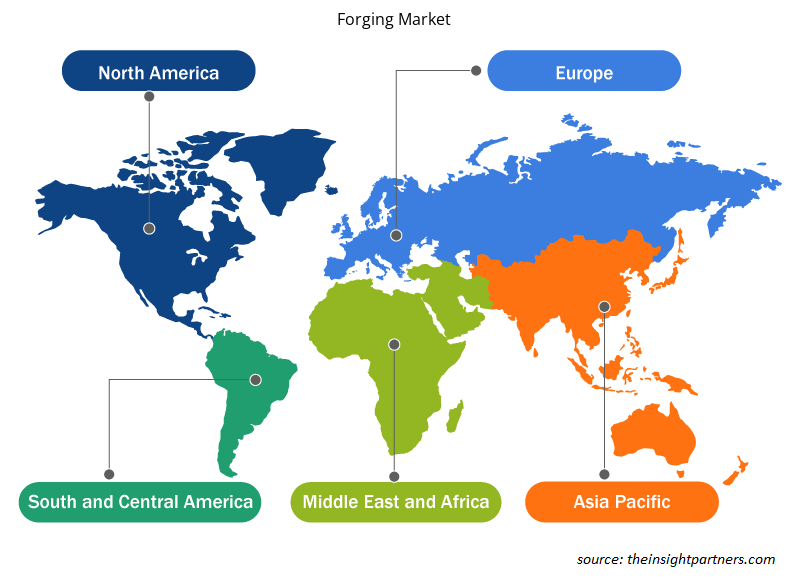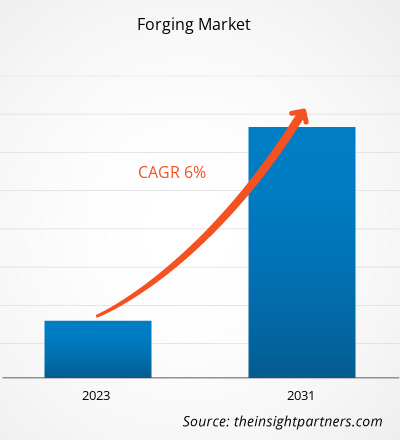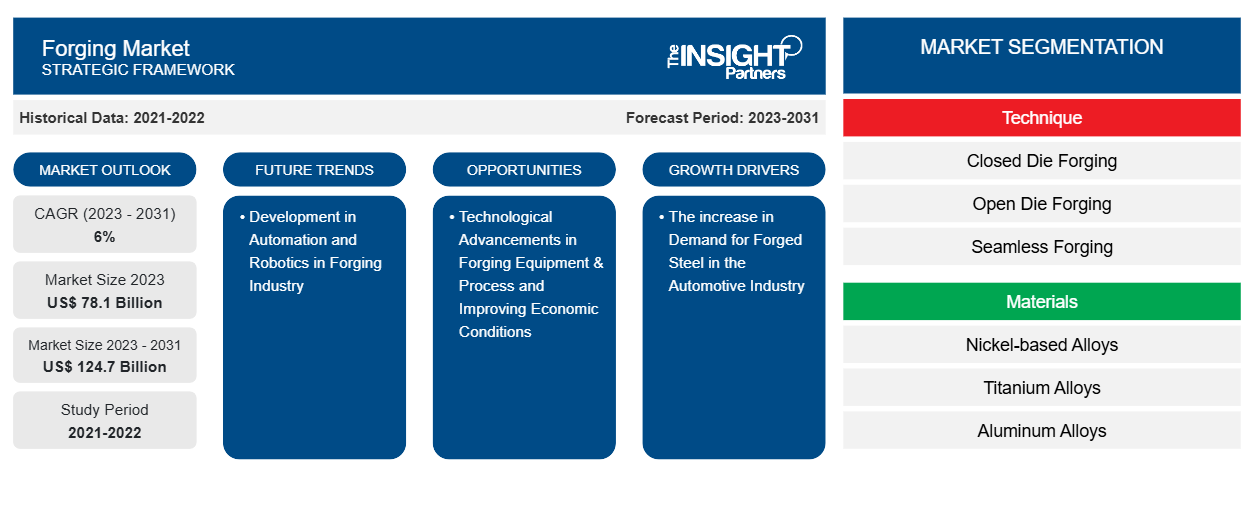Si prevede che la dimensione del mercato della forgiatura raggiungerà i 124,7 miliardi di dollari entro il 2031, rispetto ai 78,1 miliardi di dollari del 2023. Si prevede che il mercato registrerà un CAGR del 6% nel periodo 2023-2031. Un aumento degli investimenti nella generazione di energia rinnovabile e una maggiore domanda da parte dei settori aerospaziale, automobilistico e delle costruzioni sono alcuni fattori che guidano il mercato della forgiatura.
Analisi di mercato della forgiatura
Il mercato globale della forgiatura sta crescendo modestamente a causa della crescente domanda da parte dell'industria automobilistica e aerospaziale. L'aumento del traffico passeggeri aereo ha portato all'espansione del settore aerospaziale, incrementando la produzione di parti aerospaziali forgiate. Inoltre, vari governi in tutto il mondo stanno investendo sempre di più in progetti di energia eolica, il che sta aumentando la domanda di componenti forgiati per l'energia eolica. Tuttavia, la disponibilità di sostituti economici e i costi elevati stanno frenando in una certa misura l'espansione del mercato della forgiatura.
Panoramica del mercato della forgiatura
Con l'aumento della popolazione e dell'industrializzazione, la domanda di energia sta aumentando a livello globale. L'aumento del consumo di energia ha aumentato la necessità di investimenti in impianti di produzione di energia e sviluppo delle infrastrutture, spingendo ulteriormente la domanda di componenti forgiati come raccordi, flange, valvole, prigionieri, recipienti e dadi. L'industria della forgiatura ha raggiunto un posto significativo nell'economia industriale globale producendo componenti con vantaggi unici che sono difficili da duplicare. La resistenza, l'affidabilità e la durata dei componenti forgiati li hanno resi la scelta preferita in una varietà di applicazioni industriali in cui la durata della fatica e la tenacità alla frattura sono fondamentali per la sicurezza delle persone e delle attrezzature.
Personalizza questo report in base alle tue esigenze
Riceverai la personalizzazione gratuita di qualsiasi report, comprese parti di questo report, o analisi a livello nazionale, pacchetto dati Excel, oltre a usufruire di grandi offerte e sconti per start-up e università
-
Scopri le principali tendenze di mercato in questo rapporto.Questo campione GRATUITO includerà analisi di dati che spaziano dalle tendenze di mercato alle stime e alle previsioni.
Creare driver e opportunità di mercato
Aumento della domanda di acciaio forgiato nel settore automobilistico
La durevolezza, l'affidabilità e la resistenza delle forgiature in acciaio le rendono la scelta preferita nel settore automobilistico. L'acciaio inossidabile, la lega e l'acciaio al carbonio sono tra i tipi di acciaio ampiamente utilizzati nel settore automobilistico per la produzione di vari componenti come bielle, bracci di controllo, bilancieri, alberi motore, alberi a camme, estremità dei tiranti e fusi a snodo. Il processo di forgiatura dell'acciaio può produrre parti automobilistiche con forme quasi nette, senza richiedere ulteriori lavorazioni tramite il metodo a matrice chiusa, risparmiando così denaro e tempo. Inoltre, il metodo di forgiatura a matrice chiusa può essere utilizzato per personalizzare tutti i tipi di componenti automobilistici realizzati in leghe di acciaio, come l'acciaio ASTM4140 e l'acciaio AISI 1045. Le tecniche di forgiatura dell'acciaio a matrice chiusa sono utilizzate principalmente per la produzione di parti automobilistiche per vari veicoli commerciali e passeggeri e forgiature in acciaio leggero per veicoli elettrici (EV). Pertanto, il crescente utilizzo di acciaio forgiato nel settore automobilistico sta guidando il mercato della forgiatura.AISI 1045 steel. The closed die steel forging techniques are mostly used for manufacturing automotive parts for various commercial and passenger vehicles and lightweight steel forgings for electric vehicles (EVs). Thus, the growing use of forged steel in the automotive industry is driving the forging market.
Miglioramento delle condizioni economiche e progressi tecnologici nelle attrezzature e nei processi di forgiatura
Nei settori in rapido sviluppo, la domanda di prodotti forgiati complessi e innovativi è in aumento. Il processo automatizzato di forgiatura a matrice chiusa ha attirato l'attenzione dei fornitori di attrezzature verso lo sviluppo di nuove attrezzature e processi di forgiatura. Nelle applicazioni aerospaziali commerciali, queste nuove macchine per forgiatura sono in grado di forgiare parti in lega di nichel e titanio extra-large. Attualmente, l'automazione nel settore ha un impatto positivo moderato sulla crescita del mercato della forgiatura a matrice chiusa, ma si prevede che aumenterà durante il periodo di previsione.
Le aziende che operano in questo mercato sono impegnate a fornire processi di forgiatura snelli, resilienti, flessibili e adattabili per sostenere la crescente concorrenza nel mercato della formatura dei metalli. Inoltre, i settori di utilizzo finale come petrolio e gas, cantieristica navale, automotive, produzione di energia, aerospaziale e edilizia stanno vivendo una crescita significativa in nazioni come India e Cina per i prodotti forgiati a matrice chiusa. Pertanto, si prevede che il miglioramento delle condizioni economiche e le costanti innovazioni tecnologiche nelle tecniche di forgiatura forniranno opportunità nel mercato della forgiatura durante il periodo di previsione.
Analisi della segmentazione del rapporto di mercato sulla forgiatura
I segmenti chiave che hanno contribuito alla derivazione dell'analisi del mercato della forgiatura sono tecnica, materiale e settore.
- In base alla tecnica, il mercato della forgiatura è stato suddiviso in forgiatura a matrice chiusa, forgiatura a matrice aperta e forgiatura senza saldatura. Il segmento della forgiatura a matrice chiusa ha detenuto la quota di mercato maggiore nel 2023.
- In base al materiale, il mercato della forgiatura è stato suddiviso in leghe a base di nichel, leghe di titanio, leghe di alluminio, leghe di acciaio e altre. Il segmento delle leghe di acciaio ha detenuto la quota di mercato maggiore nel 2023.
- Per settore, il mercato è segmentato in automotive , aerospaziale, ferroviario, macchinari pesanti ed energia eolica. Il segmento automotive ha dominato il mercato nel 2023.
Analisi della quota di mercato per area geografica
L'ambito geografico del rapporto sul mercato della forgiatura è suddiviso principalmente in cinque regioni: Nord America, Europa, Asia Pacifico, Medio Oriente e Africa, Sud e Centro America.
L'Asia Pacifico ha dominato il mercato della forgiatura nel 2023. Il mercato della forgiatura dell'Asia Pacifico è suddiviso in Australia, Cina, Giappone, India, Corea del Sud e resto dell'Asia Pacifico. Si prevede che la crescente domanda di componenti forgiati in metallo da applicazioni tra cui ferrovia, edilizia, produzione di energia, aerospaziale e automotive alimenterà la crescita del mercato della forgiatura durante il periodo di previsione. La Cina è il principale consumatore e produttore di forgiati in metallo nell'Asia Pacifico. La Cina esporta un gran numero di prodotti forgiati nei paesi americani ed europei. La presenza di varie associazioni in Cina che lavorano per la crescita del processo di forgiatura è uno dei principali fattori che contribuiscono alla crescita del mercato della forgiatura. Inoltre, a causa della pressione del mercato e del governo, l'industria della forgiatura cinese si sta impegnando per produrre forgiati con maggiore precisione, maggiore efficienza, digitalizzazione più pervasiva, peso più leggero e minor consumo energetico. Di recente sono stati osservati molti risultati eccellenti nella ricerca e sviluppo e produzione di macchinari per forgiatura, applicazione della simulazione, applicazione IT e in particolare forgiatura di precisione.
Approfondimenti regionali sul mercato Forging
Le tendenze regionali e i fattori che influenzano il Forging Market durante il periodo di previsione sono stati ampiamente spiegati dagli analisti di Insight Partners. Questa sezione discute anche i segmenti e la geografia del Forging Market in Nord America, Europa, Asia Pacifico, Medio Oriente e Africa e Sud e Centro America.

- Ottieni i dati specifici regionali per il mercato della forgiatura
Ambito del rapporto sul mercato della forgiatura
| Attributo del report | Dettagli |
|---|---|
| Dimensioni del mercato nel 2023 | 78,1 miliardi di dollari USA |
| Dimensioni del mercato entro il 2031 | 124,7 miliardi di dollari USA |
| CAGR globale (2023-2031) | 6% |
| Dati storici | 2021-2022 |
| Periodo di previsione | 2023-2031 |
| Segmenti coperti |
Per tecnica
|
| Regioni e Paesi coperti |
America del Nord
|
| Leader di mercato e profili aziendali chiave |
|
Forgiare la densità degli attori del mercato: comprendere il suo impatto sulle dinamiche aziendali
Il mercato del Forging Market sta crescendo rapidamente, spinto dalla crescente domanda degli utenti finali dovuta a fattori quali l'evoluzione delle preferenze dei consumatori, i progressi tecnologici e una maggiore consapevolezza dei vantaggi del prodotto. Con l'aumento della domanda, le aziende stanno ampliando le loro offerte, innovando per soddisfare le esigenze dei consumatori e capitalizzando sulle tendenze emergenti, il che alimenta ulteriormente la crescita del mercato.
La densità degli operatori di mercato si riferisce alla distribuzione di aziende o società che operano in un particolare mercato o settore. Indica quanti concorrenti (operatori di mercato) sono presenti in un dato spazio di mercato in relazione alle sue dimensioni o al valore di mercato totale.
Le principali aziende che operano nel mercato della forgiatura sono:
- Società Alcoa
- Tutti i metalli e il gruppo Forge
- Azienda: CFS Machinery Co., Ltd.
- Ficep SpA
- Bharat Forge Limited
- Tecnologie Allegheny Incorporate
Disclaimer : le aziende elencate sopra non sono classificate secondo un ordine particolare.

- Ottieni una panoramica dei principali attori del mercato della forgiatura
Notizie e sviluppi recenti del mercato della forgiatura
Il mercato della forgiatura viene valutato raccogliendo dati qualitativi e quantitativi dopo la ricerca primaria e secondaria, che include importanti pubblicazioni aziendali, dati associativi e database. Di seguito sono elencati alcuni degli sviluppi nel mercato della forgiatura:
- Ad aprile 2024, Ramkrishna Forgings ha firmato un accordo di fornitura con il più grande produttore di veicoli elettrici per passeggeri negli Stati Uniti. Attraverso questo accordo, l'azienda fornirà componenti del gruppo propulsore e debutterà come fornitore nel mercato dei veicoli elettrici degli Stati Uniti.
- A febbraio 2024, US Forged Rings ha annunciato un investimento di 700 milioni di dollari nel settore eolico offshore per la costruzione di un impianto di fabbricazione di torri e di un impianto di forgiatura dell'acciaio. Attraverso questo sviluppo, l'azienda rafforzerà la sua posizione sul mercato.
Copertura e risultati del rapporto sul mercato della forgiatura
Il rapporto "Dimensioni e previsioni del mercato della forgiatura (2021-2031)" fornisce un'analisi dettagliata del mercato che copre le seguenti aree:
- Definizione delle dimensioni e delle previsioni del mercato a livello globale, regionale e nazionale per tutti i segmenti di mercato chiave coperti dall'ambito
- Forgiare le tendenze e le dinamiche del mercato, come driver, vincoli e opportunità chiave
- Analisi dettagliata delle cinque forze PEST/Porter e SWOT
- Analisi di mercato che coprono le principali tendenze di mercato, il quadro globale e regionale, i principali attori, le normative e gli sviluppi recenti del mercato
- Analisi del panorama industriale e della concorrenza che copre la concentrazione del mercato, l'analisi della mappa di calore, i principali attori e gli sviluppi recenti per il mercato della forgiatura
- Profili aziendali dettagliati
- Analisi storica (2 anni), anno base, previsione (7 anni) con CAGR
- Analisi PEST e SWOT
- Valore/volume delle dimensioni del mercato - Globale, Regionale, Nazionale
- Industria e panorama competitivo
- Set di dati Excel
Report recenti
Testimonianze
Motivo dell'acquisto
- Processo decisionale informato
- Comprensione delle dinamiche di mercato
- Analisi competitiva
- Analisi dei clienti
- Previsioni di mercato
- Mitigazione del rischio
- Pianificazione strategica
- Giustificazione degli investimenti
- Identificazione dei mercati emergenti
- Miglioramento delle strategie di marketing
- Aumento dell'efficienza operativa
- Allineamento alle tendenze normative























 Ottieni un campione gratuito per - Mercato della forgiatura
Ottieni un campione gratuito per - Mercato della forgiatura